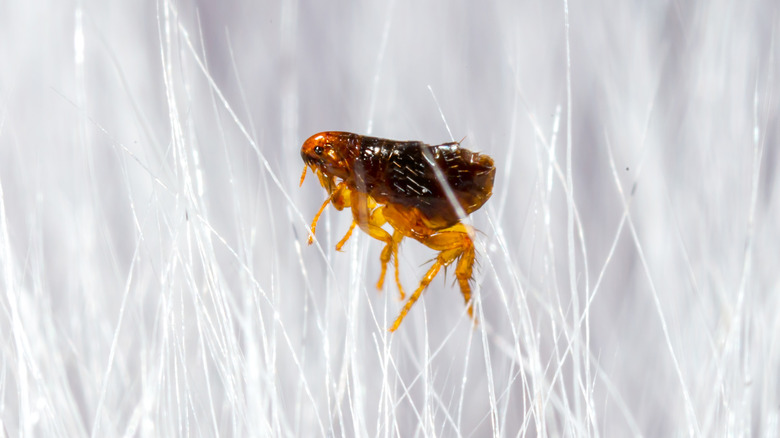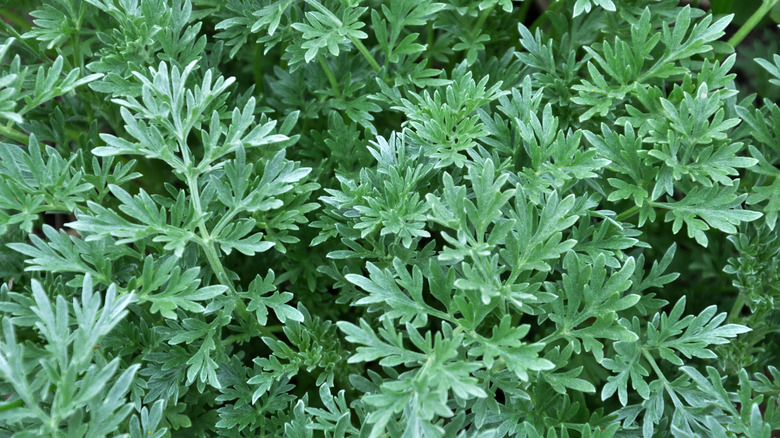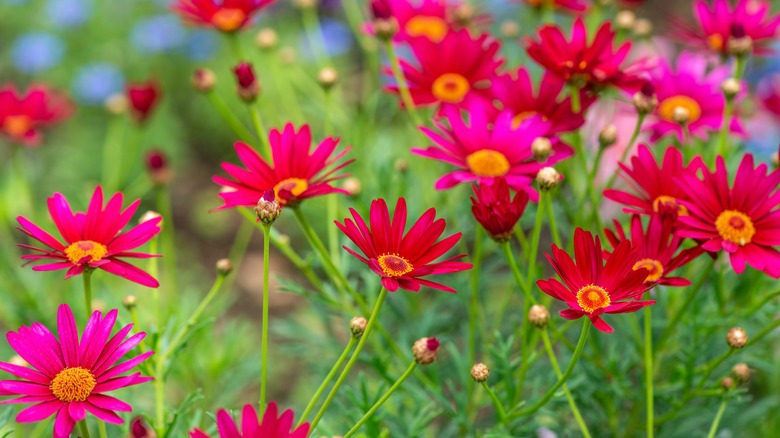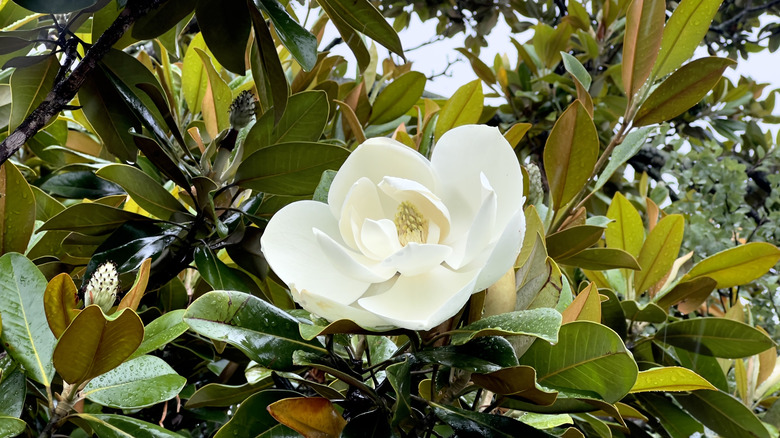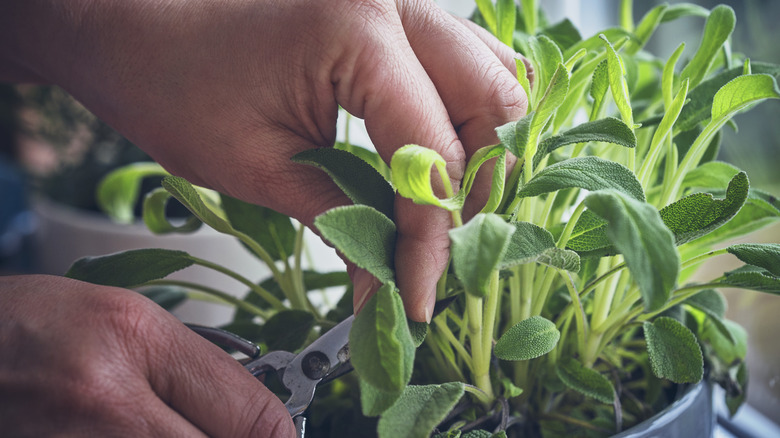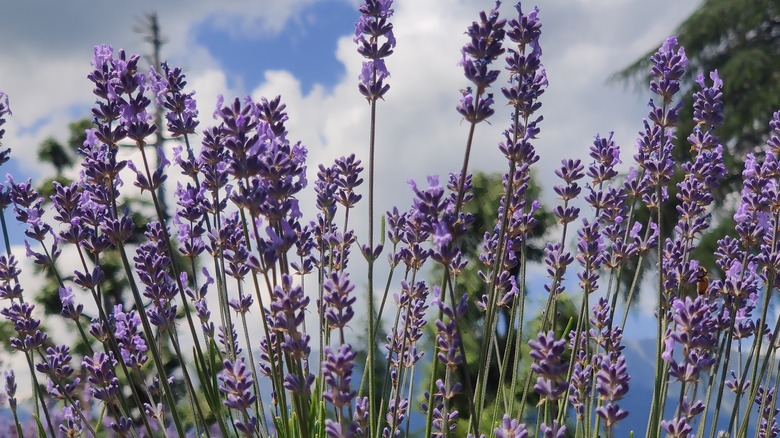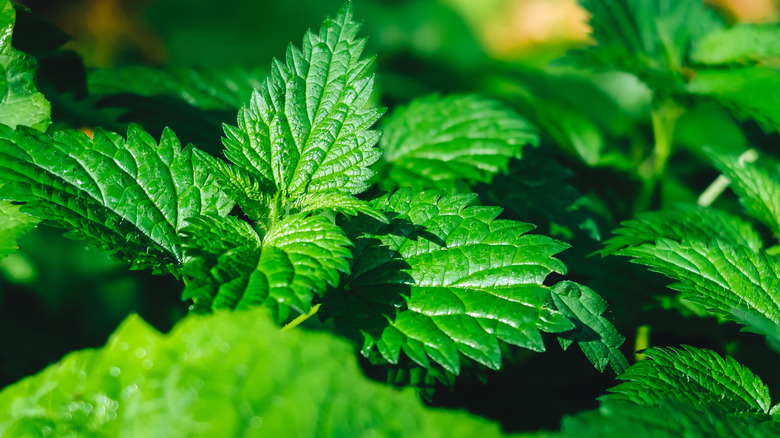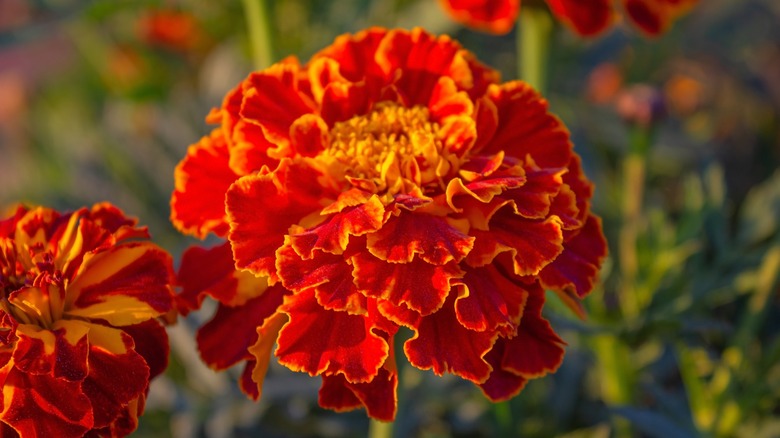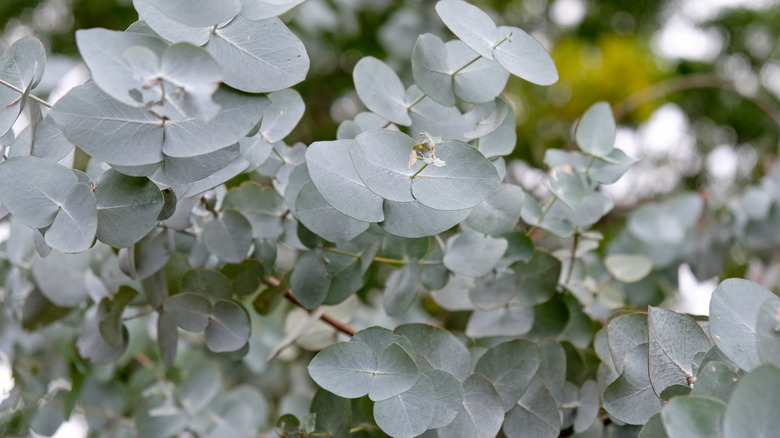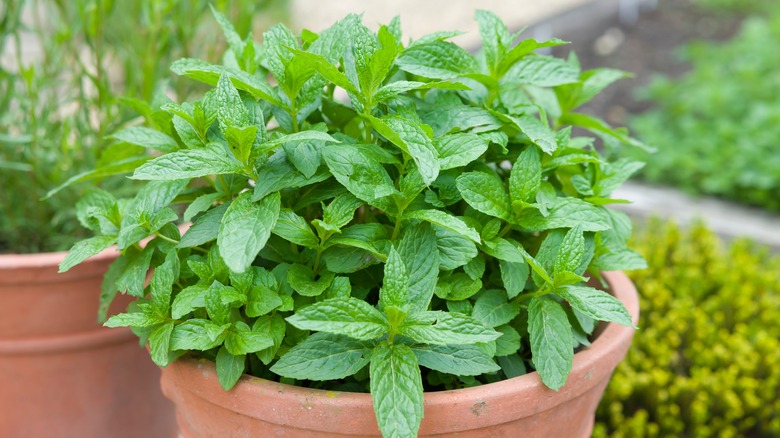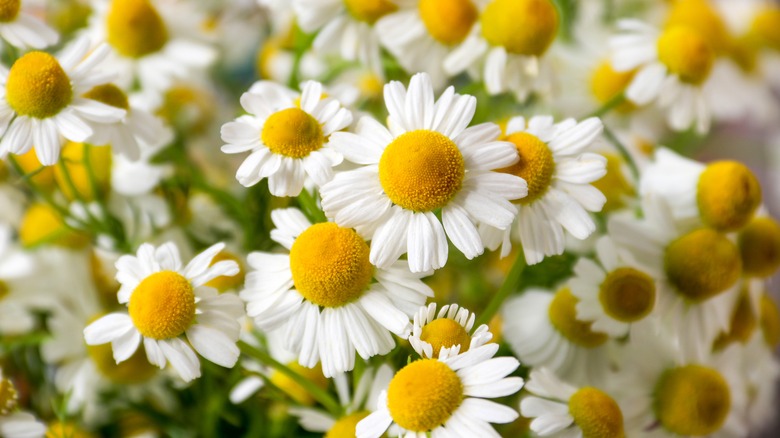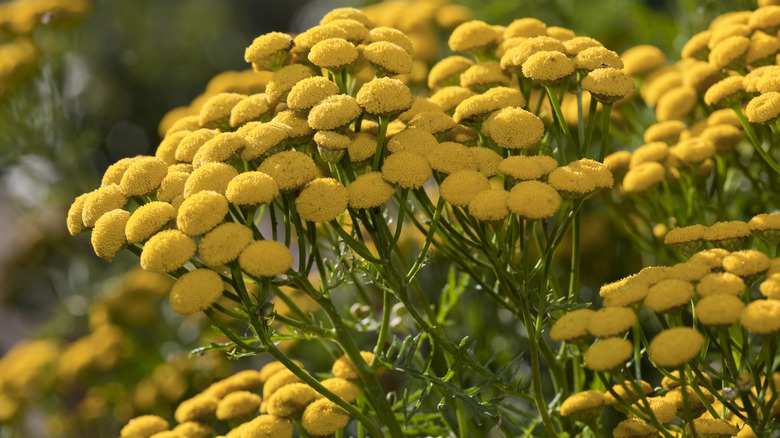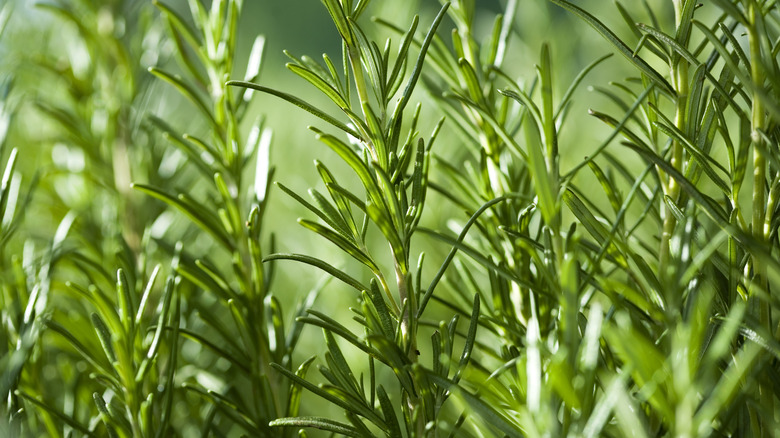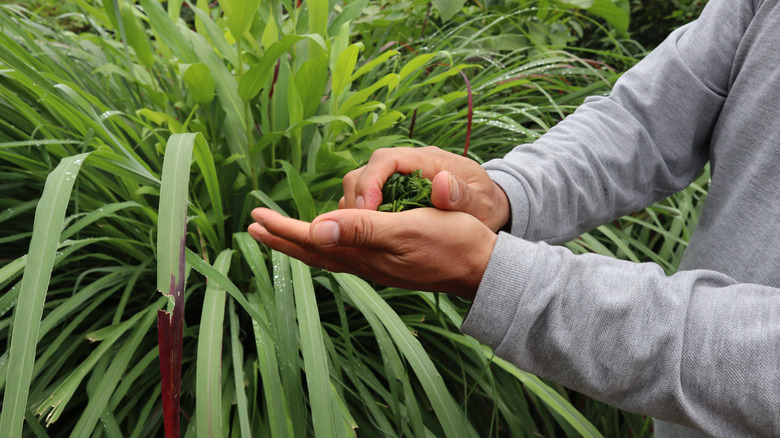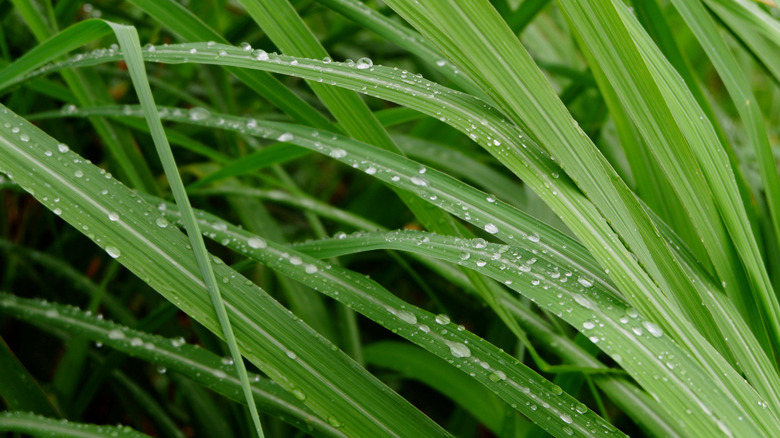Add These Gorgeous Plants To Your Yard To Ward Off Pesky Fleas
Fleas suck, literally. But, they don't have to feast on your blood or your pets when you have the right tools to keep them away. Our favorite method consists of planting one or more aromatic species to ward off these pests. In the past, people have used fleabane daisies (Erigeron annuus) as a flea-specific deterrent, yet, even though the flower is named for its suspected proficiency in banishing fleas, this daisy-like plant has been proven ineffective. Still, there is a multitude of species, particularly in the mint family, that can actually repel fleas and other pests like them, using their scents and essential oils.
Don't forget that the plants in this collection cannot, or are unlikely to, kill fleas in your yard. They simply make herb, flower, and vegetable gardens less attractive to the insects. If your flea problem has become serious, you'll need to rid your home of fleas first. Afterward, you can prevent them from rearing their tiny heads again with certain plants including the following trees, flowers, and herbs.
1. Wormwood
Wormwood (Artemisia absinthium), which is also called absinthe, is an herb used in the flavoring of the boozy drink. However, this plant has even more uses in the garden. The fragrant herb's scent repels blood-sucking fleas from your yard. Keep in mind though, that wormwood is known to attract aphids, moths, and grasshoppers that could damage vegetables, flowers, and more.
Bloom Season: Fall and summer
USDA Growing Zone: 3 to 9
Growing Conditions: Full sun to partial shade
Soil Type: Evenly moist and well-draining
Size: 2 to 5 feet tall and wide
2. Painted daisies
Painted daisies (Tanacetum coccineum) are among the best species to plant in your yard if you are having a problem with fleas. These flowers are not only quite beautiful, but they contain a natural insecticide called pyrethrin. In the summer, the center of the blooms can be deadly to fleas that thrive in warm and humid environments that gardens in many regions create. Still, they are more likely to repel the pests first.
Bloom Season: Summer
USDA Growing Zone: 3 to 7
Growing Conditions: Full sun to partial shade
Soil Type: Well-draining
Size: 1 to 3 feet tall
3. Sweetbay
Sweetbay magnolia (Magnolia virginiana) is a type of tree that is well-suited to growing in urban landscapes. Adding it to your backyard could help manage your flea problem as its leaves contain eugenol. To humans, this makes the leaves smell sweet, but fleas find it unsavory. The tree grows quite easily and offers shade from its green canopy of foliage and scented flowers.
Bloom Season: Spring and summer
USDA Growing Zone: 5 to 9
Growing Conditions: Full sun to partial shade
Soil Type: Evenly moist and well-draining
Size: 40 to 50 feet tall and 15 to 25 feet wide
4. Sage
Sage (Salvia officinalis) is a shrub in the mint family that is closely related to rosemary. Like rosemary, this herb is used in the kitchen as well as in traditional medicine practices. When sage is planted in a garden plot with well-draining soil and plenty of direct sunlight, it can also ward off a variety of pests including fleas.
Bloom Season: Summer
USDA Growing Zone: 4 to 10
Growing Conditions: Full sun
Soil Type: Well-draining
Size: Up to 30 inches tall and 24 inches wide
5. Lavender
To fleas, lavender plants (Lavandula angustifolia) smell terrible which deters them from living in your garden. Of course, the purple-blooming plant won't kill fleas that have already invaded, but it could convince them to move elsewhere. Lavender, thankfully, is simple to grow and it'll come back year after year in most climates.
Bloom Season: Summer
USDA Growing Zone: 5 to 8
Growing Conditions: Full sun
Soil Type: Light, sandy, and well-draining
Size: 3 feet tall and 4 feet wide
6. Catnip
Catnip plants (Nepeta cataria) are known for their ability to attract felines to their scented leaves. However, as a member of the Lamiaceae family, the catnip plant also repels a handful of pests including fleas. When you plant the herb in your garden, you can help protect your kitties from the blood-sucking insect as they rub up against its fragrant foliage.
Bloom Season: Spring
USDA Growing Zone: 3 to 9
Growing Conditions: Full sun
Soil Type: Well-draining
Size: 3 feet tall and wide
7. Marigolds
French marigold flowers (Tagetes patula) are orange-blooming annuals that are commonly added to garden beds for their roots, stems, leaves, and blossoms that can scare off some pests. Growing these flowers around your garden won't only ward off invaders, but they'll also add a nice pop of color for several months during the growing season.
Bloom Season: Spring to fall
USDA Growing Zone: 2 to 11
Growing Conditions: Full sun to partial shade
Soil Type: Well-draining
Size: 6 to 12 inches tall
8. Eucalyptus
Likely, you are familiar with the scent of eucalyptus (Eucalyptus cinerea) which has been used to fragrance lotions, room sprays, bath soaks, and more. However, you may not be aware that this scent comes from silver dollar trees' circular leaves. This tree, which can grow to 60 feet tall, is actually suitable for container growing. Doing so keeps it small and allows gardeners in colder climates to bring the eucalyptus inside during the winter.
Bloom Season: Spring
USDA Growing Zone: 8 to 11
Growing Conditions: Full sun
Soil Type: Well-draining loam or sand
Size: Up to 60 feet
9. Mint
Similarly to catnip, mint plants' (Mentha spp.) abilities to drive out fleas in your yard are sometimes glossed over. Instead, we tend to focus on its value in the kitchen for mojitos or mint chocolate. If you're already growing mint in your garden, it's worth more than you think. This plant, and its many variations, has a very sharp scent that pests hate, thus it repels bugs like fleas from ever entering.
Bloom Season: Summer
USDA Growing Zone: 3 to 8
Growing Conditions: Full sun to partial shade
Soil Type: Well-draining
Size: Up to 3 feet tall
10. Chamomile
If you've ever given your pets chamomile baths, you know how successful your chamomile plants (Matricaria recutita) can be for ridding a place of fleas. This natural flea-repelling flower doubles as a classic ingredient in tea as well as an ornamental species for an herb or flower garden. Just keep in mind that the plant is an annual, so it will need replanting each year unless it's able to self-seed.
Bloom Season: Summer
USDA Growing Zone: 2 to 8
Growing Conditions: Full sun
Soil Type: Well-draining
Size: 12 to 24 inches tall and 9 to 12 inches wide
11. Tansy
Tansy (Tanacetum vulgare) is a yellow-blooming weed that will need to be carefully controlled if you are planting it near your yard. People tend to grow this one to keep ticks away, which are repulsed by the insecticide, thujone, that is present in all parts of the tansy plant. However, its problematic growth has turned many off from bringing it into their yard. Plant tansy at your own risk.
Bloom Season: Summer
USDA Growing Zone: 3 to 8
Growing Conditions: Full sun to partial shade
Soil Type: Moist, humusy, and well-draining
Size: 1 to 3 feet tall and wide
12. Rosemary
Rosemary (Salvia rosmarinus) is among the most successful flea repellents. The perennial plant can produce a large bushy habit with many stems donning fragrant leaves. Planting these bushes around your property can help keep away fleas as well as ticks and mosquitos. Remember that they can't withstand temperatures below 20 degrees Fahrenheit. They are better suited to more temperate regions, not cold ones.
Bloom Season: Spring and summer
USDA Growing Zone: 8 to 10
Growing Conditions: Full sun
Soil Type: Well-draining
Size: 4 to 6 feet tall and wide
13. Citronella
Speaking of mosquitoes, citronella (Cymbopogon nardus) is another great plant for repelling those tiny blood-suckers, but they aren't the only pest deterred by the leafy plant. Fleas are also thought to be driven away by citronellas foliage. This plant, which features scented strap-like leaves, is most often harvested for its essential oils which are used for their pest-deterring gifts.
USDA Growing Zone: 10 to 11
Growing Conditions: Full sun to partial shade
Soil Type: Well-draining
Size: 5 to 8 feet tall and 3 to 5 feet wide
14. Lemongrass
Lemongrass (Cymbopogon citratus) is related to citronella, but it features skinnier leaves and a diluted lemon scent. The ornamental grass is best grown as a perennial in warm climates that can support its need for direct sunlight and high temperatures or as an annual in colder areas. Provided with some moisture and organically rich soil, your lemongrass plant can serve you with its pest-repelling foliage, similar to citronella.
USDA Growing Zone: 10 to 11
Growing Conditions: Full sun
Soil Type: Organically rich and well-draining
Size: 2 to 4 feet tall and 2 to 3 feet wide
